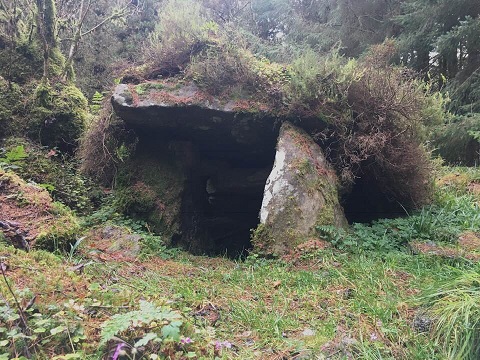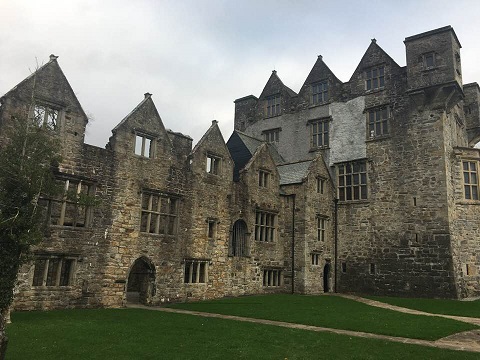For weeks of
November 12 and 19
In next week’s post, I’ll wrap up our
thoughts on what we accomplished at Fort Tombecbe this season. However, this
week’s final blog posts from the students for 2018 are about their trip to
Ireland. Sarah, Michael, Daniel, and Sparky were part of a group of 25 UWA
students who participated in the UWA in Ireland course “Culture, Nation, and
the State in Ireland,” co-taught by Dr. Lesa Shaul (English), Dr. Rob Riser
(History), and me. We were there for ten days over the Thanksgiving Holiday and
visited many historical and archaeological sites. We hope you enjoy their posts
about some of their favorite places.
Neolithic Passage Tombs
By Michael Hornsby
Hello again everyone!!
As a few of
you know, the 2018 Field School has decided to take one heck of a break. All of
us, and I do mean all of us, will be leaving the country and coming back in a
little over a week. We will be going to Ireland and looking at various
archaeological sites to get a better understanding of a different culture. In
addition to this instead of just hearing from me, you will also get an article
on a different subject from every other student who has been posting articles
over the past semester. Don’t worry though, mine will still be here if you get
sick of reading the others. On that note, I think it is time to get going so I
will finish this on the return trip.
Alright guys,
we are officially, and sadly, back in the States. I will be covering a little
bit about the history and structure of passage tombs and a few that we saw
while there. So, for anyone who doesn’t know what a passage tomb is, here is a
random definition you can find online:
A passage
grave or passage tomb consists of a narrow passage made
of large stones and one or multiple burial chambers covered in
earth or stone. The building of passage tombs was normally
carried out with megaliths and smaller stones; they usually date from the
Neolithic Age.
Now that that boring
definition is out of the way, imagine a hallway with one or two doors branching
off and then put that inside a circle. You now have at the simplest level the
base plan of a passage tomb. 

One
of the coolest things about a passage tomb is the precision of them to this
day. I know some of you must be thinking what is precise about a big pile of
rocks. Well, the passages are usually lined up with a solstice or equinox that
will only occur one day out of a year. Now think of when these were built 5,000
years ago, they didn’t have electronics or fancy equipment. These were hand
built and the rocks used were brought in sometimes from far away. These tombs
took years to build and still to this day line up with the sun or sunset one
day out of the year. The people who were buried in them were usually a
chieftain and other members of his extended family. The big tombs helped mark
their territory to farming land in a particular region. We visited the Loughcrew Passage Tomb (image 1) and
the Creevykeel tomb (images 2 and 3), both dating to the Neolithic about 3500
BC, or more than 5000 years ago.
Cavan Burren
By Daniel Rhodes
Sadly, this will be my final
blog entry for the semester. I have really learned a lot and had a lot of fun
doing it. So, we as a class decided to do something a little different for our
final entries, as some of you may know the four of us Michael, Sarah, Connor
and myself recently went on a school trip to Ireland and we each decided to
write about something we liked or something we learned on the trip. I chose to
write about Cavan Burren. Cavan Burren is a massive Archaeological and Geological
marvel. It’s full of wide-open spaces, beautiful forests and so much more. Our
guide Seamus (He has a last name, but I won’t even attempt to try and spell
it.) took us through the sprawling landscapes and told us the history of the
park, like the Glacier erratics, which are large stones that had been
transported by a glacier and left behind after it melted), and early stone
works that if you look really close you could see the tool marks, even though
they were thousands of years old. He also shared a little folklore about the
fairies that lived in the forest. Cavan Burren has passage tombs (see image
below) and many large circles made of stones, which were probably Neolithic houses
or enclosures for houses. It is no surprise that the Celtic people who showed
up thousands of years later made up stories about giants and fairies to explain
these abandoned stone structures. All in all, it was awesome and that was just
small part of a truly amazing trip.

Bog Bodies
By Sarah Coffey
The last couple days of our
trip to Ireland were spent in Dublin. On Saturday, we spent the morning at the
National Museum of Natural History and Archaeology. Among the exhibits were some
of the world-famous bog bodies. True to their name, the bodies are recovered
from peat bogs around Europe. Due to the cool, waterlogged environment, the
peat turns acidic with low levels of oxygen that almost perfectly preserve any
organic material. Four bog bodies found in Irish peat bogs were on display with
information on their discovery. All of the bodies on display were dated to the
Early Iron Age between 400 BC and 400 AD. The oldest, Gallagh Man, is a nearly
complete set of remains. The skin was paper-thin, covering bone. After reading
the plaque discussing his discovery in the early 19th century, I
learned that Gallagh Man is slowly disintegrating. Upon first being discovered,
he had some hair and parts of a beard left, but over the years, they have
disappeared, leaving bare skin that barely covers his skull. Probably the most
fascinating were Oldcroghan Man and Clonycavan Man. Although the only pieces
recovered was the torso and arms and the head (in the case of Clonycavan Man),
they are probably the most well preserved of the bog bodies on display.The skin
of both bodies has turned brown and slightly dry from the tanic acid in the
peat bog, but they are the most human-like. Oldcroghan still had very
noticeable fingernails on his hands and Clonycavan still had hair on his
crushed-head.Overall, being able to see this exhibit gave more insight on how
different environments can preserve human remains and other archaeological
artifacts in different ways.
Donegal Castle
By Connor Sparks
On our trip to Ireland, we had
the opportunity to visit Donegal Town in the County of Donegal. There we were
able to go to a castle that was owned by the O’Donnell clan, one of the most
powerful Gaelic families in Ireland from the 5th to 16th
centuries. The castle is beautiful; it sits on a small water way, and the keep
has three stories of wonderful architecture and held so much history in its
walls. During 1607, the leaders of the O’Donnell clan fled Ireland after a
failed revolt from the English and the lands were given to an English Captain
by the name of Basil Brooke. Once given the castle, he made many additions to
the castle, windows, a gable and a manor house wing to the side of the keep.
With the additions to the castle, the Brookes family renovated the 2nd
and 3rd floor of the keep. They wanted a homier feeling than that of
the Gaelic style. The bottom floor stayed the same because they had no use or
need to go there because it was for the servants and help. When we walked
through the castle and walking on the same floor that people that long ago
walked on was amazing. If you ever find yourself in Ireland, do yourself the
favor and travel to Ulster, County Donegal and then to Donegal Town to visit
this magnificent piece of architecture and history.
